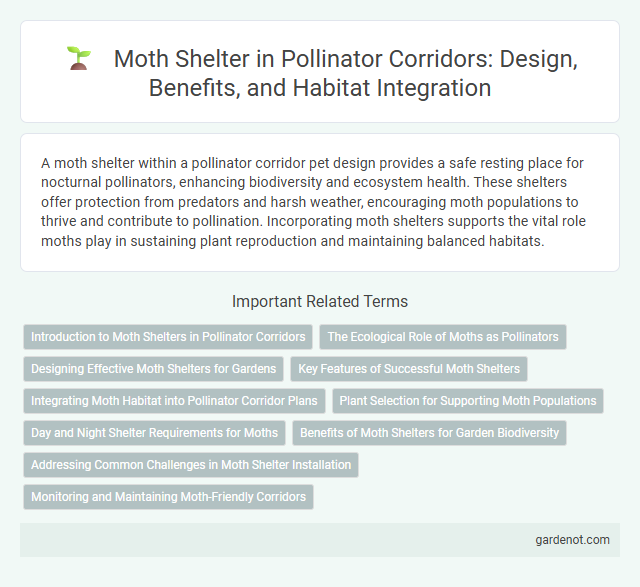A moth shelter within a pollinator corridor pet design provides a safe resting place for nocturnal pollinators, enhancing biodiversity and ecosystem health. These shelters offer protection from predators and harsh weather, encouraging moth populations to thrive and contribute to pollination. Incorporating moth shelters supports the vital role moths play in sustaining plant reproduction and maintaining balanced habitats.
Introduction to Moth Shelters in Pollinator Corridors
Moth shelters serve as vital microhabitats within pollinator corridors, providing safe resting and breeding spaces for nocturnal pollinators. These structures enhance biodiversity by supporting moth populations, which contribute significantly to pollination and the broader ecosystem. Strategically placed moth shelters can improve habitat connectivity, promoting healthier pollinator networks and ecosystem resilience.
The Ecological Role of Moths as Pollinators
Moth shelters provide critical habitats that support moth populations, enhancing their role as nocturnal pollinators in pollinator corridors. Moths contribute to the pollination of night-blooming plants, facilitating biodiversity and ecosystem stability. Protecting these shelters helps maintain moth-mediated pollination networks essential for agricultural productivity and native plant reproduction.
Designing Effective Moth Shelters for Gardens
Designing effective moth shelters for gardens involves creating dark, humid, and undisturbed spaces that mimic natural resting sites such as tree bark or leaf litter. Incorporate rough wooden boards or inverted flower pots with ventilation gaps to provide safe daytime refuge from predators and harsh weather. Position shelters near nectar-rich plants to support moth populations essential for pollination and biodiversity.
Key Features of Successful Moth Shelters
Successful moth shelters incorporate dark, sheltered spaces that protect moths from predators and harsh weather conditions. Key features include rough surfaces or natural materials like wood and bark for moths to cling to during rest. Proper placement in shaded, undisturbed areas enhances shelter effectiveness, promoting nocturnal pollinator activity within pollinator corridors.
Integrating Moth Habitat into Pollinator Corridor Plans
Integrating moth habitat into pollinator corridor plans enhances biodiversity by providing essential shelter and breeding sites for nocturnal pollinators. Designing corridors with native vegetation, including trees and shrubs that support moth life cycles, strengthens ecological networks and improves pollination services. Moth shelters contribute to ecosystem resilience by sustaining populations critical for plant reproduction and food webs.
Plant Selection for Supporting Moth Populations
Selecting native plants such as evening primrose, wild tobacco, and yarrow enhances moth populations by providing essential nectar sources and larval host plants. Incorporating a variety of flowering species that bloom at night supports nocturnal moth feeding and reproduction cycles. Choosing plants with diverse bloom times ensures continuous food supply, promoting a thriving moth shelter within the pollinator corridor.
Day and Night Shelter Requirements for Moths
Moth shelters must provide protection from predators and harsh weather conditions during both day and night. These shelters typically require dense foliage or specialized structures that offer cool, dark, and humid environments to support moths' resting and breeding needs. Ensuring continuity in shelter availability within pollinator corridors enhances moth population stability and promotes effective pollination.
Benefits of Moth Shelters for Garden Biodiversity
Moth shelters provide critical habitats that support the lifecycle of various moth species, enhancing garden biodiversity by attracting natural pollinators and predators of pests. These shelters create safe spaces for moths to rest and reproduce, leading to increased pollination and a balanced ecosystem. By fostering moth populations, gardens benefit from improved pollination rates and natural pest control, promoting overall plant health and diversity.
Addressing Common Challenges in Moth Shelter Installation
Effective moth shelter installation requires selecting locations with minimal light pollution to prevent disorientation and ensure natural behavior. Utilizing breathable, durable materials helps protect moths from harsh weather conditions while maintaining proper ventilation. Incorporating native plant species around shelters enhances habitat suitability and provides essential resources for moth populations.
Monitoring and Maintaining Moth-Friendly Corridors
Effective monitoring of moth shelters within pollinator corridors involves regular inspections to ensure structural integrity and suitable microhabitats that support various moth species. Maintaining moth-friendly corridors requires planting native night-blooming flowers and minimizing artificial light pollution to enhance moth navigation and feeding. Recording species diversity and abundance helps track population trends and assess the success of habitat management practices.
Moth shelter Infographic

 gardenot.com
gardenot.com